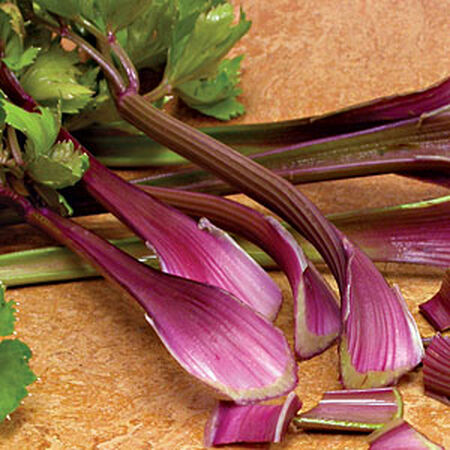Giant Red, (F1) Celery Seeds
Key Attributes
Key Attributes
Product Details
Weight
0.006Depth
0.05Height
4.5Width
3.25Plant Height
16-24"Botanical Name
Apium graveolensSeed Type
SeedAdditional Characteristics
Best Tasting Vegetables,Cool Season Vegetables,Heat Tolerant VegetablesSeeds Per Gram
2,576Seeds Per Pound
1,168,000Row Spacing
24-36"Packet
250 SeedsSow Depth
1/8"Seeds Per Ounce
73,000Fruit Color
GreenBreed
F1 HybridSun
Full Sun / Partial ShadeGrowing Conditions
Heat TolerantLife Cycle
AnnualSow Method
TransplantPlant Spacing
6-8"Categories
CeleryGermination
11,12,13,14,7,8,9,10Days To Maturity (# Days)
85Seeds Per Acre
12 oz.Components
Growing Instructions
![]() Learning Download: How to Grow Celery
Learning Download: How to Grow Celery
Celery tastes better grown from the garden, but to grow celery requires patience and skill. Celery is a low-calorie, high-nutrient vegetable used for its seeds, stalks and leaves. The vegetable is most often used as a garnish or a healthy snack.
Before Planting: Celery seeds are very small and difficult to plant. To aid in planting, mix the seeds with a little bit of sand and then sprinkle the mixture over soil.
Planting: Sow 10–12 weeks before transplanting outdoors. Sow 2-3 seeds per cell, ⅛” deep. Keep soil moist and temperatures 70°F if possible. Seedlings emerge in 2–3 weeks and then temperature can be reduced to 60°F. Do not harden off celery plants by lowering temperatures! Give more sunlight and wind conditions slowly over 7-10 days until ready for outdoor conditions. Do not expose to weather below 50°F.Transplant 10-12 week seedlings outdoors when weather is warm and settled (late spring). Set plants 6–8″ apart in rows 24–36″ apart. Irrigate to keep soil moist.
Watering: Make sure celery is planted in the lowest area of the garden, as it requires lots of water.Do not let the soil dry out, indoors or out. Celery needs constant supply of water to give best flavor and yield.
Fertilizer: Celery requires a fertile soil with a pH range of 6.0–7.0. Add compost and mulch around the
plants to help retain moisture. Sometimes, celery stalks will split if they do not receive enough moisture.
Days to Maturity: Celery can take up to 140 days before it is ready to harvest.
Harvesting: Cut stalks when desired size. Stalks may be blanched if desired by hilling up with soil or by placing paper collars around plants. Harvest in morning when heat is at a minimum. May be dunked in cold water to bring temperature down if harvested in warm temperatures. Store roots at 32°F with 98–100% relative humidity. Celery will store for 1–2 months. We suggest blanching for best eating quality celery.
Tips: In rare instances contact with the foliage can result in a severe rash. When working with this crop on hot, sunny days, we recommend wearing long sleeves and long pants and washing any exposed skin surfaces as soon as possible after contact.
PREPARATION: Celeraic requires a fertile soil with a pH range of 6.0–7.0. Do not let the soil dry out, indoors or out. Needs constant supply of water to give best flavor and yield.
GROWING SEEDLINGS: Sow 10–12 weeks before transplanting outdoors. Sow 2-3 seeds per cell, ⅛” deep. Keep soil moist and temperatures 70°F if possible. Seedlings emerge in 2–3 weeks and then temperature can be reduced to 60°F.
TRANSPLANTING: Transplant 10-12 week seedlings outdoors when weather is warm and settled (late spring). Set plants 6–8″ apart in rows 24–36″ apart. Irrigate to keep soil moist.
HARDENING: Do not harden off celeriac plants by lowering temperatures! Give more sunlight and wind conditions slowly over 7-10 days until ready for outdoor conditions. Do not expose to weather below 50°F.
HARVEST: Cut stalks when desired size. Stalks may be blanched if desired by hilling up with soil or by placing paper collars around plants. We suggest blanching for best eating quality celery.
STORAGE: Harvest in morning when heat is at a minimum. May be dunked in cold water to bring temperature down if harvested in warm temperatures. Store roots at 32°F with 98–100% relative humidity. Celeriac will store for 1–2 months.
Shipping Schedule
Our Seed Promise
 "Agriculture and seeds" provide the basis upon which our lives depend. We must protect this foundation as a safe and genetically stable source for future generations. For the benefit of all farmers, gardeners and consumers who want an alternative, we pledge that we do not knowingly buy or sell genetically engineered seeds or plants.
"Agriculture and seeds" provide the basis upon which our lives depend. We must protect this foundation as a safe and genetically stable source for future generations. For the benefit of all farmers, gardeners and consumers who want an alternative, we pledge that we do not knowingly buy or sell genetically engineered seeds or plants.
The mechanical transfer of genetic material outside of natural reproductive methods and between genera, families or kingdoms, poses great biological risks as well as economic, political, and cultural threats. We feel that genetically engineered varieties have been insufficiently tested prior to public release. More research and testing is necessary to further assess the potential risks of genetically engineered seeds. Further, we wish to support agricultural progress that leads to healthier soils, to genetically diverse agricultural ecosystems, and ultimately to healthy people and communities.
To learn more about the "Safe Seed Pledge" please visit www.councilforresponsiblegenetics.org.

